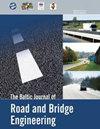Rural Two-Lane Two-Way Three-Leg and Four-Leg Stop-Controlled Intersections: Predicting Road Safety Effects
IF 1.1
4区 工程技术
Q4 ENGINEERING, CIVIL
引用次数: 6
Abstract
The study focused on grade-level rural two-lane two-way three-leg and two-lane two-way four-leg stop-controlled intersections located in the flat area with a vertical grade of less than 5%. The goal is to calibrate one Safety Performance Function at these intersections by implementing a Generalized Estimating Equation with a binomial distribution and compare to the results with yearly expected crash frequencies by using models mainly refered to the scientific literature. The crash data involved 77 two-lane two-way intersections, of which 25 two-lane two-way three-leg intersections are without a left-turn lane (47 with left-turn lane), 5 two-lane two-way four-leg intersections without a left-turn lane (6 with a left-turn lane). No a right-turn lane is present on the major roads. Explanatory variables used in the Safety Performance Function are the presence or absence of a left-turn lane, mean lane width including approach lane and a left-turn lane width on the major road per travel direction, the number of legs, and the Total Annual Average Daily Traffic entering the intersection. The reliability of the Safety Performance Function was assessed using residuals analysis. A graphic outcome of the Safety Performance Function application has been plotted to easily assess a yearly expected crash frequency by varying the Average Annual Daily Traffic, the number of legs, and the presence or absence of a left-turn lane. The presence of a left-turn lane significantly reduces the yearly expected crash frequency values at intersections.农村两车道双向三腿和四腿停车控制交叉口:道路安全效应预测
研究的重点是位于垂直坡度小于5%的平坦地区的等级级农村两车道双向三腿和两车道双向四腿停车控制交叉口。目标是通过实现具有二项分布的广义估计方程来校准这些十字路口的一个安全性能函数,并使用主要参考科学文献的模型将结果与年预期碰撞频率进行比较。碰撞数据涉及77个双车道双向交叉口,其中25个双车道双向三腿交叉口没有左转车道(47个有左转车道),5个双车道双向四腿交叉口没有左转车道(6个有左转车道)。在主要道路上没有右转车道。安全性能函数中使用的解释变量包括是否存在左转车道、平均车道宽度(包括每个行驶方向上的进近车道和左转车道宽度)、分支数以及进入路口的年平均每日交通量。使用残差分析评估安全性能函数的可靠性。安全性能函数应用程序绘制了一个图形结果,通过改变平均年每日交通量、腿的数量以及是否存在左转弯车道,可以轻松评估年度预期碰撞频率。左转弯车道的存在显著降低了交叉路口每年预期的碰撞频率值。
本文章由计算机程序翻译,如有差异,请以英文原文为准。
求助全文
约1分钟内获得全文
求助全文
来源期刊
CiteScore
2.10
自引率
9.10%
发文量
25
审稿时长
>12 weeks
期刊介绍:
THE JOURNAL IS DESIGNED FOR PUBLISHING PAPERS CONCERNING THE FOLLOWING AREAS OF RESEARCH:
road and bridge research and design,
road construction materials and technologies,
bridge construction materials and technologies,
road and bridge repair,
road and bridge maintenance,
traffic safety,
road and bridge information technologies,
environmental issues,
road climatology,
low-volume roads,
normative documentation,
quality management and assurance,
road infrastructure and its assessment,
asset management,
road and bridge construction financing,
specialist pre-service and in-service training;

 求助内容:
求助内容: 应助结果提醒方式:
应助结果提醒方式:


